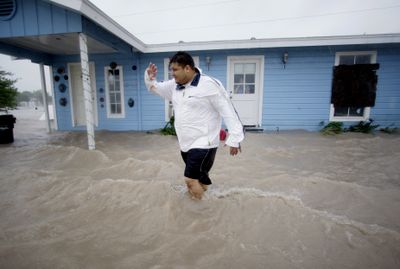Hurricane Dolly dumps rain but spares levees in Texas
Storm downgraded after forcing thousands into public shelters

BROWNSVILLE, Texas – Hurricane Dolly barreled into South Texas on Wednesday, lashing the coast with winds up to 100 mph and dumping heavy rain that flooded some low-lying areas but spared levees along the heavily populated Rio Grande Valley.
Authorities had feared the first hurricane to hit the U.S. since last September could produce up to 20 inches of rain in some areas, possibly breaching levees in the Rio Grande Valley. But shortly before its center came ashore, the Category 2 storm meandered 35 miles north of the border, veering away from the flood walls.
“We’re not experiencing any issues with the levees right now,” said Sally Spener, spokeswoman for the International Boundary and Water Commission. “The water is just not high enough. We are not experiencing flood conditions (on the Rio Grande).”
Dolly was downgraded to a tropical storm late Wednesday night, and authorities in Texas and Mexico were watching for flooding. About 5,000 people went to public shelters in three Texas counties hit hardest by the storm. More were expected as night fell and at least 50,000 customers were left without power.
Most of the destruction from wind was on the resort island of South Padre Island, where the hurricane’s center came ashore and knocked out power to thousands of homes, ripped off roofs and smashed windows.
Roads and yards were strewn with toppled trees, fences, power poles and streetlights. Business signs rolled around the streets like tumbleweeds. The causeway linking the island to the mainland was closed.
Between 5 and 12 inches of rain had fallen in Brownsville’s Cameron County by Wednesday evening and another 3 to 7 inches was expected during the night, according to the National Weather Service. Estimates in Laguna Vista and Bayview reached 12 inches.
No deaths were immediately reported in Mexico, but Tamaulipas state Gov. Eugenio Hernandez said 50 neighborhoods were still in danger from flooding. About 13,000 people had taken refuge in 21 shelters, he said.
“Strong winds are no longer the problem. Now we have to worry about intense rain in the next 24 hours,” Hernandez said.
Earlier in the day, Mexican soldiers made a last-minute attempt to rescue people at the mouth of the Rio Grande, using an inflatable raft to retrieve at least one family trapped in their home.
At 8 p.m. PDT Wednesday, the storm’s center was about 55 miles northwest of Brownsville and moving west at about 7 mph. The storm’s maximum sustained winds had weakened to about 70 mph. Forecasters expected it could be downgraded to a tropical depression by today.
Dolly spawned thunderstorms as far away as Houston, 400 miles up the coast. Tornado watches were in effect for many coastal counties between Corpus Christi and Houston.
The U.S. Census Bureau said that based on Dolly’s projected path, about 1.5 million Texans could feel the storm’s effects. Gov. Rick Perry declared 14 south Texas counties disaster areas and sought federal disaster declarations.
As Dolly approached, oil and gas companies in the Gulf of Mexico evacuated workers from 62 production platforms and eight rigs, according to the U.S. Minerals Management Service, which monitors offshore activity.
The last hurricane to hit the U.S. was the fast-forming Humberto, which came ashore in South Texas last September. Dolly is the 26th hurricane to make landfall in the U.S. in July since record keeping started in 1851, according to federal researchers.
The busiest part of the Atlantic hurricane season is usually in August and September.
So far this year, there have been four named storms, two of which became hurricanes.
Federal forecasters predict a total of 12 to 16 named storms and six to nine hurricanes this season.